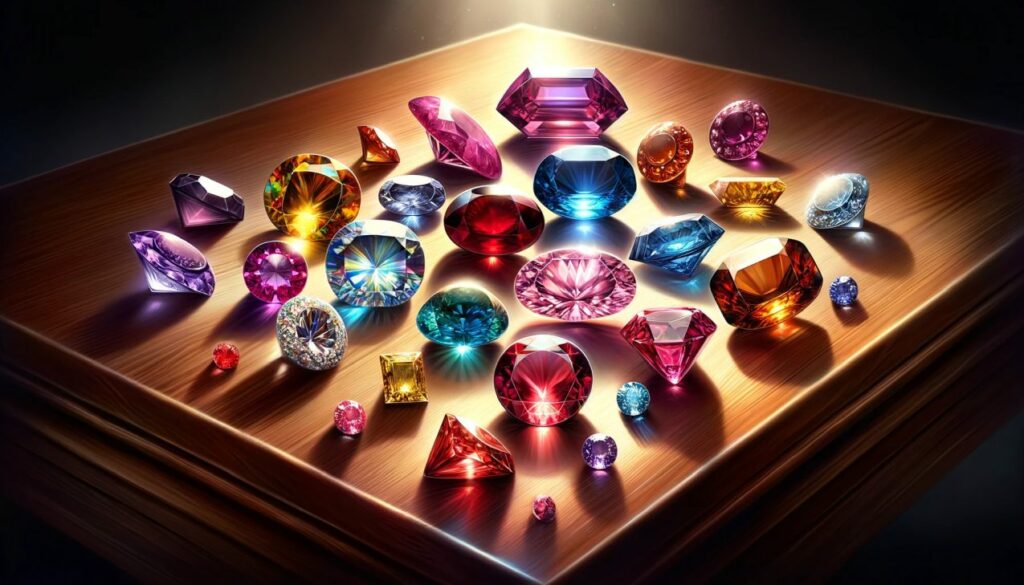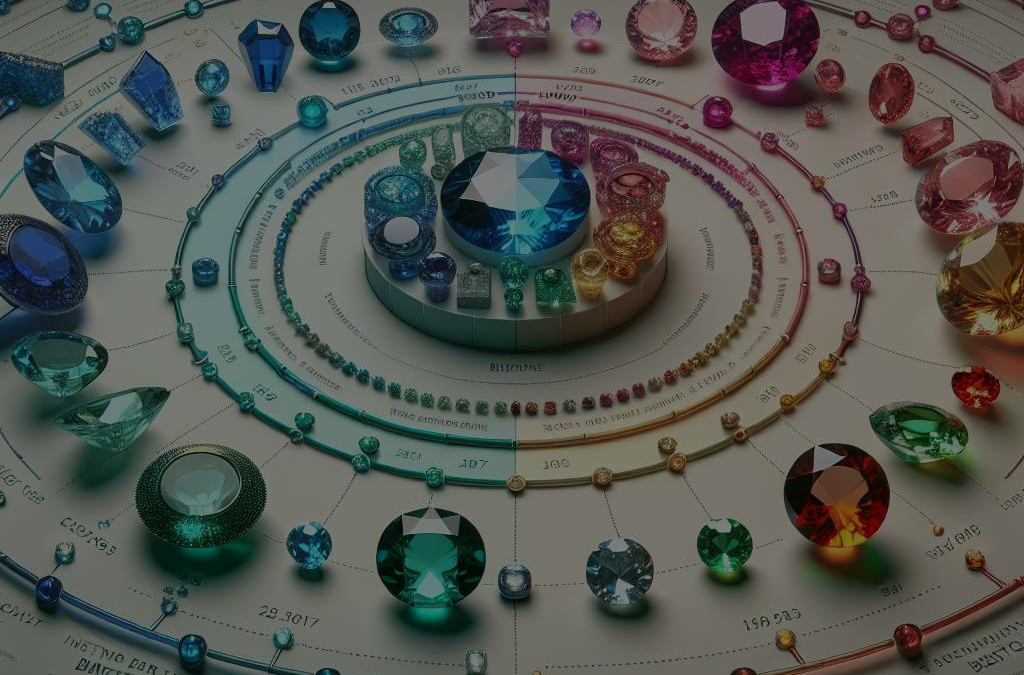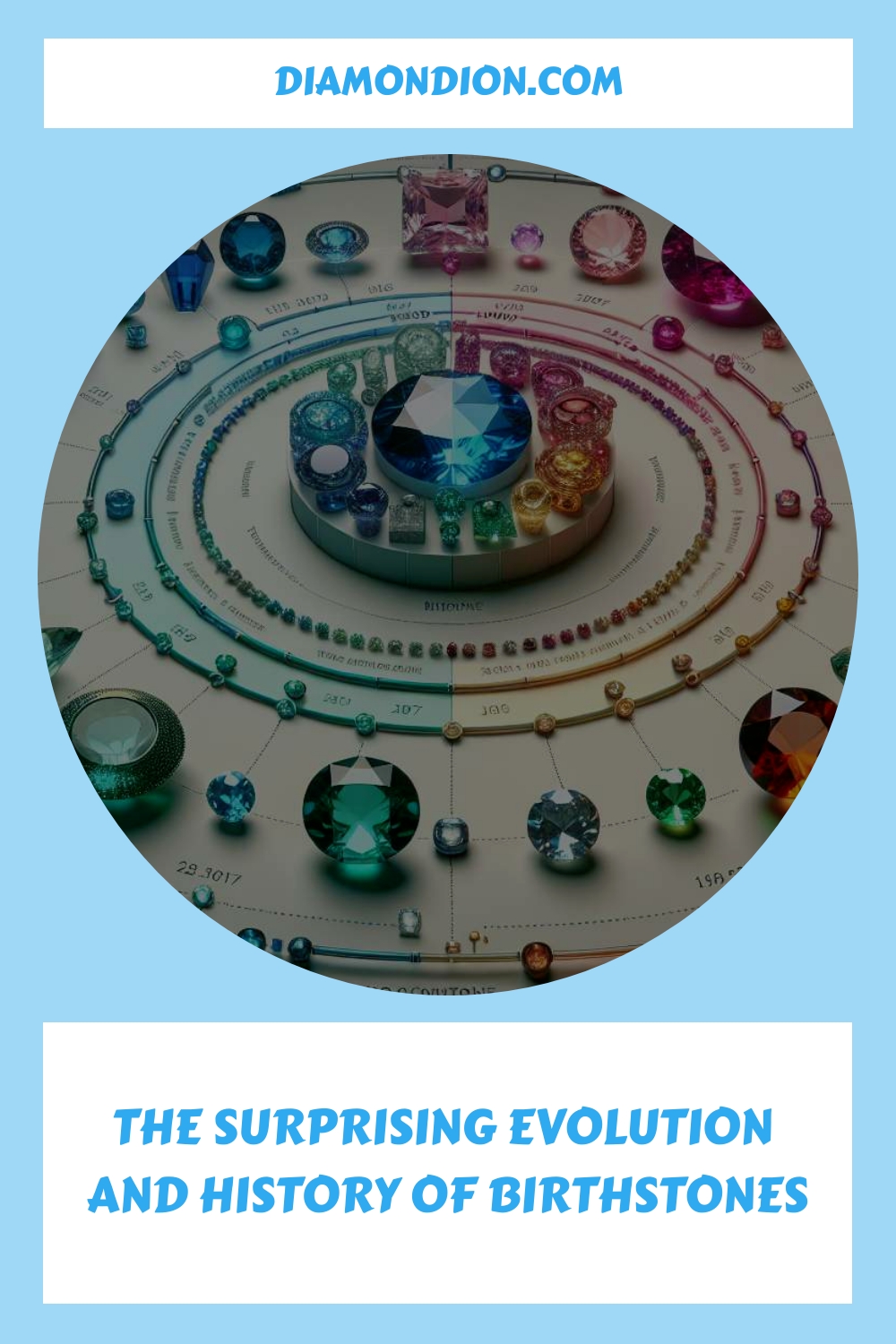Article Contents
Birthstones have a rich history that can be traced back to biblical times. Over the years, the list of birthstones has evolved and changed. In this article, we’ll look at the history of birthstones and how the American National Association of Jewelers has standardized them.
The History of Birthstones Has an Ancient Origin
Birthstones have a long and fascinating history, with their roots dating back to ancient times. The concept of twelve gemstones, corresponding to each month of the year, can be traced back to biblical times and Aaron’s breastplate. Different cultures throughout history have assigned specific gemstones to each month, with each stone believed to possess unique properties and bring good luck to those born in their corresponding month.
Gemstones and the Bible
The association of gemstones with specific months can be traced back to the Bible. In the Book of Exodus, Aaron, the brother of Moses and the first high priest of the Israelites is described as wearing a breastplate adorned with twelve different gemstones. Each gemstone represented one of the twelve tribes of Israel. The breastplate was believed to hold mystical powers and was worn as a symbol of divine guidance and protection.
Over time, the connection between the twelve gemstones and the months of the year was established, leading to the concept of birthstones.
Cultural Assignments of Birthstones
Throughout history, different cultures have assigned specific gemstones to each month, often based on astrological or symbolic associations. These assignments vary across different cultures and time periods, but certain gemstones have remained consistent for certain months.
For example, the modern Western birthstone assignments are as follows:
- January: Garnet
- February: Amethyst
- March: Aquamarine
- April: Diamond
- May: Emerald
- June: Pearl
- July: Ruby
- August: Peridot
- September: Sapphire
- October: Opal
- November: Topaz
- December: Turquoise
These gemstones carry different meanings and are believed to bring good luck, protection, and various other benefits to those who wear them.

Symbolism and Powers
Ancient cultures attributed various symbolic meanings and powers to different gemstones based on their unique characteristics and appearance.
For example:
- Garnet: Associated with love, passion, and protection from evil.
- Amethyst: Symbolises wisdom, spirituality, and peace of mind.
- Aquamarine: Believed to bring courage, calmness, and clarity.
- Diamond: Represents purity, strength, and everlasting love.
- Emerald: Associated with fertility, rebirth, and good fortune.
- Pearl: Symbolises purity, femininity, and emotional healing.
- Ruby: Believed to bring passion, vitality, and protection.
- Peridot: Associated with healing, prosperity, and positive energy.
- Sapphire: Represents loyalty, wisdom, and protection from harm.
- Opal: Symbolizes creativity, inspiration, and hope.
- Topaz: Believed to bring abundance, success, and good health.
- Turquoise: Associated with friendship, happiness, and spiritual healing.
These associations have evolved over time and may vary across different cultures and belief systems. However, the belief in the power and significance of birthstones continues to this day.
Whether you subscribe to the mystical properties of birthstones or simply appreciate their beauty, there is no denying the enduring allure of these gemstones. From ancient times to the modern day, birthstones have captivated the human imagination and hold a special place in our hearts.
Standardization by the American National Association of Jewelers
In 1912, the American National Association of Jewelers took a significant step toward creating a more organized approach to birthstones. They introduced a standardized birthstone list, which aimed to simplify the selection process for individuals looking to celebrate their birth month with a gemstone.
The creation of this standardized list was based on two important factors: the colour and availability of gemstones. By considering these aspects, the Association sought to provide a consistent and widely accepted birthstone list that would be both practical and meaningful.
The first criterion for determining birthstones was colour. Each month was assigned a specific colour or range of colours that best represented its unique essence. By associating gemstones with particular colours, the Association aimed to provide a visual connection between the stones and the characteristics associated with each birth month.
For example, January’s birthstone is garnet, chosen for its deep red colour. This rich hue symbolizes passion, vitality, and strength—a fitting representation for the beginning of a new year. On the other hand, May’s birthstone is emerald, chosen for its vibrant green colour, which embodies growth, renewal, and prosperity—qualities often associated with the spring season. Similarly, September’s birthstone is sapphire, known for its deep blue color, and is often associated with wisdom, loyalty, and nobility. As for those born in December, their birthstone is the vintage turquoise birthstone, which is renowned for its striking blue-green color and is believed to bring good fortune, success, and protection to the wearer. Each birthstone holds its own unique significance and has been celebrated for centuries for its beauty and symbolism.
The second criterion considered by the Association was the availability of gemstones. While certain gemstones might perfectly match a particular birth month’s colour, it was crucial that these stones be readily accessible. By selecting gemstones that were relatively easy to acquire, the Association aimed to prevent confusion and ensure that individuals could easily obtain their birthstones.
The objective of creating this standardized birthstone list was to provide a clear and reliable reference point for both jewellers and consumers. With a widely accepted list in place, it became easier for people to find birthstone jewellery that accurately represented their birth month.
The Association’s efforts resulted in a range of benefits. Firstly, jewellers were able to stock their inventory with birthstone jewellery that aligned with the standardized list. This made it simpler for customers to find their desired birthstone jewellery without having to search through an overwhelming array of options.
Secondly, consumers were better equipped to make informed choices. They no longer had to struggle with conflicting birthstone information or guesswork. The standardized list provided reassurance and confidence in their decision to purchase birthstone jewellery, knowing that they were selecting an appropriate stone for their birth month.
Moreover, the standardized birthstone list fostered a sense of unity and shared experience among individuals born in the same month. It created a connection between people with shared birthstones, serving as a reminder of their commonality. This shared experience could be found in conversations, gift exchanges, or even in comparing birthstone jewellery with others born in the same month.
In conclusion, the American National Association of Jewelers played a pivotal role in standardizing the birthstone list. By considering the colour and availability of gemstones, they created a consistent and widely accepted reference point. This standardization not only benefited jewellers by simplifying their inventory management but also empowered consumers by providing them with a reliable guide for choosing birthstone jewellery. The standardized birthstone list brought people closer together, creating a shared experience among those born in the same month.
Evolution of the Birthstone List
Over time, the birthstone list has gone through various changes, with some stones being added or switched. These changes reflect shifts in the popularity and availability of gemstones. One notable example is the addition of tanzanite as an alternative birthstone for December in 2002. Let’s take a closer look at the evolution of the birthstone list and the reasons behind these changes.
Addition of Tanzanite as a December Birthstone
In 2002, tanzanite was officially added as an alternative birthstone for December. This vibrant blue-violet gemstone gained popularity due to its unique colour and rarity. Tanzanite is found exclusively in Tanzania and is highly valued for its striking appearance. Its addition to the birthstone list provided an alternative option for those born in December, alongside the traditional blue topaz and turquoise.
Shifts in Popularity
Popularity plays a significant role in the evolution of the birthstone list. Certain gemstones may become more or less popular over time, resulting in changes to the official list. For example, diamonds have always been a symbol of eternal love and are highly sought-after. As a result, April’s birthstone has remained a diamond for many years.
On the other hand, other gemstones may fall in and out of favour due to factors such as changing fashion trends or cultural preferences. Jewellers and gemologists carefully monitor these shifts in popularity and consider them when proposing changes to the birthstone list.
Availability of Gemstones
The availability of gemstones also influences the evolution of the birthstone list. Some gemstones may become scarce or difficult to obtain due to various reasons, such as limited mining operations or geopolitical factors. In such cases, alternative gemstones may be considered to ensure a consistent supply of birthstones.
For example, the original birthstone for February was the deep purple amethyst. However, due to its increasing rarity, an alternative birthstone, the pale purple-coloured purple spinel, was added to the list. This ensured that individuals born in February would still have a readily available birthstone to represent their birth month.
The Significance of Birthstones
Beyond their beauty and rarity, birthstones carry symbolic meanings and serve as personal talismans for those who wear them. The concept of birthstones can be traced back to ancient civilizations, where gemstones were believed to possess special powers and astrological associations.
The birthstone associated with a person’s birth month was thought to bring good luck, protection, and various other benefits. People would often wear their birthstone as jewellery or keep it close to them in some form.
Today, birthstones continue to hold meaning and serve as a way to connect with one’s birth month and harness the energy associated with the gemstone. Whether it’s a traditional birthstone or an alternative variation, each gemstone represents a unique aspect of the individual born in that month.
The birthstone list has evolved over time, incorporating new gemstones and making switches to ensure the availability and popularity of birthstones. The addition of tanzanite as a December birthstone in 2002 is just one example of these changes. As we continue to appreciate and celebrate the beauty of gemstones, the birthstone list will likely continue to evolve, reflecting the dynamic nature of the gemstone industry.
Exploring Birthstones Month by Month
1. Uncover the unique characteristics
Each birthstone has its own unique characteristics and qualities. By reading our articles, you’ll uncover the distinct features of each gemstone, including its colour variations, hardness, and rarity. You’ll gain a greater appreciation for the beauty and intricacy of these precious stones.
2. Find the perfect gift
Birthstone jewellery makes for a meaningful and personalized gift. Whether you’re looking for a present for yourself or a loved one, our website offers a wide selection of beautiful birthstone jewellery. Explore various designs and styles to find the perfect piece that resonates with the recipient.
Further Reading About The Evolution and History of Birthstones
Here are six authoritative web pages that can help research an article with the following title: The Evolution and History of Birthstones:
- Popular Gemology by Richard M. Pearl – Ebook – Everand[1]
- Winter 2002 Gems & Gemology – GIA[2]
- Sinkankas Library[3]
- Birth Month Flowers: What Is My Birth Flower? – The Old Farmer’s Almanac[4]
- A Grammar of Sentiment[5]
- Birthstones by Month – American Gem Society
These sources provide information on the history, geology, taxonomy, and gemological properties of birthstones, as well as their cultural significance and symbolism. They also cover the folklore and mythology surrounding birthstones and their use in jewellery and other decorative arts.
Citations:
[1] https://www.everand.com/book/323161377/Popular-Gemology
[2] https://www.gia.edu/doc/WN02.pdf
[3] https://www.gia.edu/doc/SP89.pdf
[4] https://www.almanac.com/content/birth-month-flowers-and-their-meanings
[5] https://core.ac.uk/download/pdf/1932944.pdf



